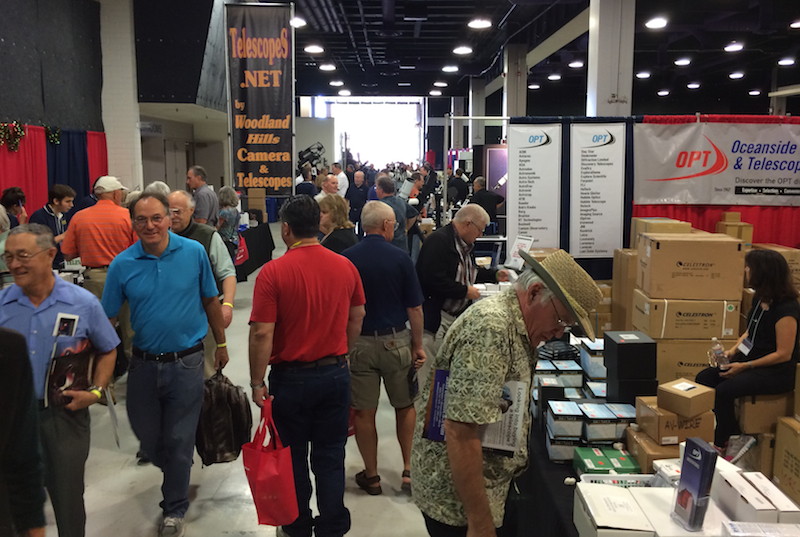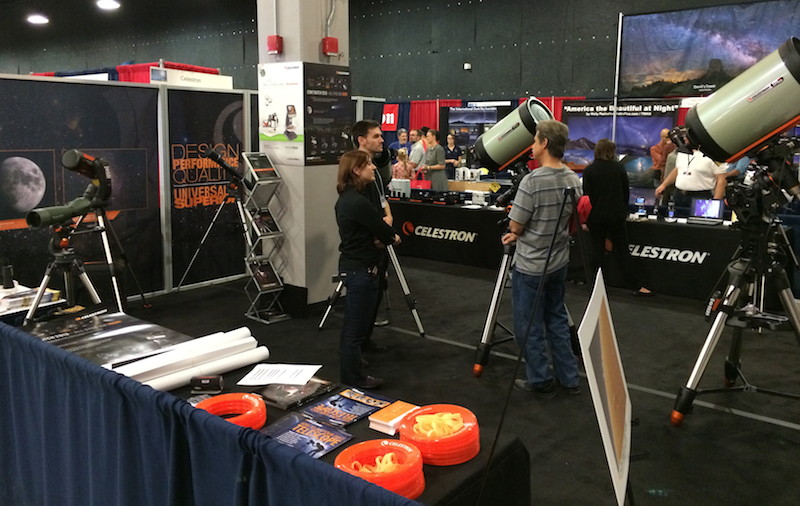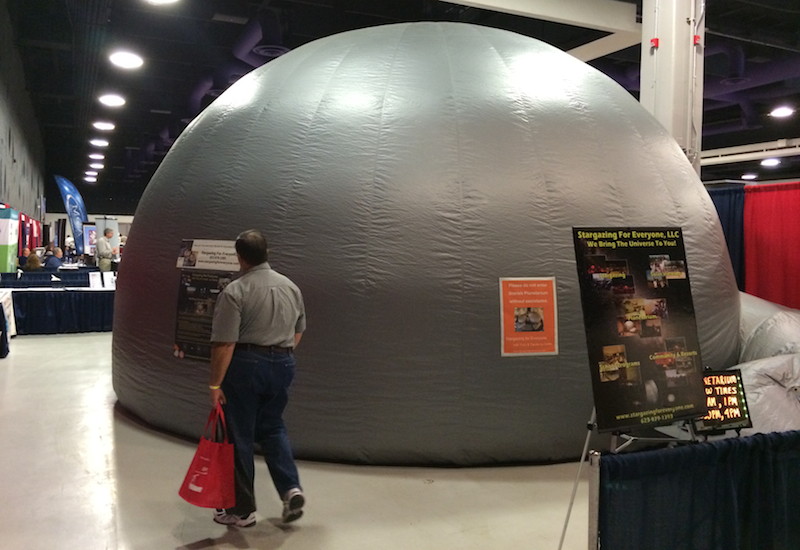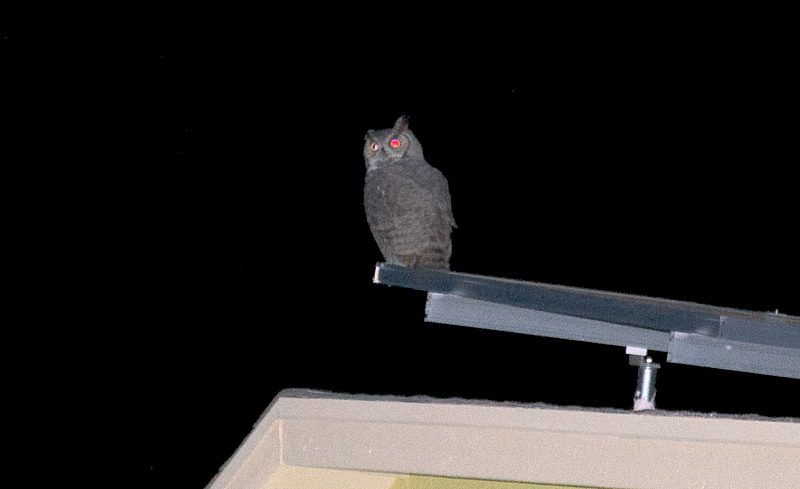
Arizona Science & Astronomy Expo 2013,
Critter, New Accessories, Moon
Posted: 19 November 2013
The sky was cloudy and winds came on Tuesday, 12 November 2013. No observing. The observatory was opened Wednesday, 13 November 2013, at 1902 MST. A niece, who was visiting from New Jersey, got to look through my 8" telescope. She loved every minute of it. She even got to take photographs of the moon using her old iPod touch. Closed the observatory at 2130 MST. Briefly opened the observatory on Thursday, 14 November, about sunset to let niece view Venus and the moon. She got some nice views. Clouds and some wind returned on Thursday, Friday, Saturday, and Sunday.
We attended the 2nd annual "Arizona Science and Astronomy Expo" on Saturday and Sunday, 16-17 November. I worked the OPT booth both days and my wife and niece attended presentations. Since I was working during the Expo, I was only able to do some quick "grab shots".
Southwest Astrophotography Seminar (Friday):




ASAE Exhibitor Floor (Saturday):

















My niece and me at the OPT booth:

Photo courtesy of Bill Winscott
Sunday, about an hour before closing time, the convention center emergency alarms started sounding! Everyone in the convention center had to evacuate. Here is a panorama photo showing some of the exhibitors standing around outside wondering what was happening:

Never learned what caused the alarm.
Sky & Telescope has a nice article about the "Arizona Science and Astronomy Expo".
Niece flew home on Monday, 18 November 2013. And of course, the sky cleared up as sunset approached. The observatory was opened at 1807 MST, 68°F. At 1813 MST, viewed Venus, 83X and 222X. Seeing was not good but the crescent phase was visible. I then had a "First Light" with my new Tele Vue 2" 2X PowerMate (purchased from OPT at their ASAE booth):

First used it with the 2" 24mm UWA eyepiece, yielding 166X. Venus looked super. Then used it with the 2" 9mm 100° eyepiece, yielding 444X. This provided a highly magnified view that was surprisingly bright. I then tested all my 1.25" eyepieces as a 1.25" adapter is included with the 2" PowerMate. The views were good with the 40mm (100X), 26mm (154X), 15mm (267X), and 9.7mm (412X). The view that really impressed me was with the Meade Series 5000 5.5mm eyepiece (yielding 727X); Venus appeared very large and yet still very bright.
At 1830 MST, I began doing some initial night time observing tests of my new Celestron Cometron 12x70 binoculars (also purchased from the OPT booth):

The eastern sky was beginning to brighten from the just past full moon. I had done some preliminary daytime terrestrial observing tests with the binoculars at the Celestron booth at ASAE and with my new binoculars on Monday. Terrestrial viewing was OK; the large binoculars are lightweight enough that they can be handheld for extended periods of time without tiring. For daytime terrestrial purposes, the views were steady even though being handheld. However, at night, steadiness is more of a problem due to the 12X magnification. As I used the binoculars more I found I could get a steadier view. Bracing my elbows on the wall of the SkyShed POD also helped. A photographic tripod adapter is included with the binoculars if you need more a more steady viewing experience. (I'll use a tripod on the next session.) I viewed Venus with the 12x70 binoculars. Venus appeared elongated due to its phase. M13 (in Hercules) was definitely a large globular cluster. The Double Cluster looked very nice, as did the Pleiades. M31 (Great Galaxy in Andromeda) looked large even though the sky was not totally dark. I tried for M57 (Ring Nebula) but the sky was not dark enough. I did observe a very faint satellite passing through Cygnus. Although the satellite was faint to the naked eye, it appeared very bright in the binoculars. Having dual 70mm aperture lenses really helps with light gathering. There is some coma around the field-of-view (FOV) edge and the eyepieces can "teeter-totter" a small amount on the focusing shaft. The crispest view is at the center. I did some comparisons with my old Orion 7x50 binoculars. The 7x50 binoculars have crisp views across the entire FOV and a handheld steadier but fainter view. The FOV was also wider with the 7x50 (6°) vs the 12x70 (4.6°). The moon rose over the hill to the east at 1908 MST and I did some moon observing with the 12x70 binoculars. The moon was gorgeous in the 12x70. There was a very slight color fringing around the moon but it was not objectionable. My initial reaction to the binoculars was generally positive given the low price. I'll know more once I use them more for dark sky observing.
I began lunar observing with the 8" LX200-ACF at 1948 MST. First, I used 222X. There was a nice terminator view. The moon was still low in the sky and seeing was not very good. I added the 2" 2X PowerMate to the 9mm (for 444X); the moon was still bright, unlike the view when using my 1.25" 2X Barlow Lens, and the FOV was still wide.
I then began hearing a owl nearby. I finally located the Great Horned Owl on the house roof:

I managed to get this close-up before the owl flew away:

I returned to the observatory and took this photo of the moon using the D7000 DSLR at 8" prime focus, 1/320sec, ISO 100:

I added the 2" 2X PowerMate for this photo of the terminator near the north pole, 1/400sec, ISO 1000:

Unlike with my 1.25" 2X Barlow Lens and 1.25" 3X TeleXtender at prime focus, there was no glare when imaging the nearly full moon with the 2X PowerMate.
I did some brief terminator observing at 2028 MST, 444X (with the PowerMate). The views were very nice. Then took a final look at the moon, 83X, at 2031 MST.
The observatory was closed at 2046 MST, 57°F.
Comments are welcome using Email. Thanks.
Cassiopeia Observatory Home Page